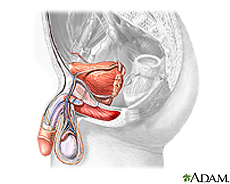
- Problems passing urine, such as pain, difficulty starting or stopping the stream, or dribbling
- Low back pain
- Pain with ejaculation
Treatment often depends on the stage of the cancer. How fast the cancer grows and how different it is from surrounding tissue helps determine the stage. Men with prostate cancer have many treatment options. The treatment that’s best for one man may not be best for another. The options include watchful waiting, surgery, radiation therapy, hormone therapy, and chemotherapy. You may have a combination of treatments.
The following risk factors may increase the risk of prostate cancer:
Age
Prostate cancer is rare in men younger than 50 years of age. The chance of developing prostate cancer increases as men get older.
Family history of prostate cancer
A man whose father, brother, or son has had prostate cancer has a higher-than-average risk of prostate cancer.
Race
Prostate cancer occurs more often in African-American
men than in white men. African-American men with prostate cancer are
more likely to die from the disease than white men with prostate cancer.
Hormones
The prostate needs male hormones to work the way it
should. The main male sex hormone is testosterone. Testosterone helps
the body develop and maintain male sex characteristics.
Testosterone is changed
into dihydrotestosterone (DHT) by an enzyme in the body. DHT is
important for normal prostate growth but can also cause the prostate to
get bigger and may play a part in the development of prostatecancer.
Vitamin E
The Selenium and Vitamin E Cancer Prevention Trial
(SELECT) found that vitamin E taken alone increased the risk of prostate
cancer. The risk continued even after the men stopped taking vitamin E.
Folic acid
Folate is a kind of vitamin B that occurs naturally
in some foods, such as green vegetables, beans and orange juice. Folic
acid is a man-made form of folate that is found in
vitamin supplements and fortified foods, such as whole-grain breads and
cereals. A 10-year study showed that the risk of prostate cancer was
increased in men who took 1 milligram (mg) supplements of folic acid.
However, the risk of prostate cancer was lower in men who had enough
folate in their diets.
Dairy and calcium
A diet high in dairy foods and calcium may cause a small increase in the risk of prostate cancer.
The following protective factors may decrease the risk of prostate cancer:Folate
Folate is a kind of vitamin B that occurs naturally
in some foods, such as green vegetables, beans and orange juice. Folic
acid is a man-made form of folate that is found in vitamin
supplements and fortified foods, such as whole-grain breads and cereals.
A 10-year study showed that the risk of prostate cancer was lower in
men who had enough folate in their diets. However, the risk of prostate
cancer was increased in men who took 1 milligram (mg) supplements of
folic acid.
Finasteride and Dutasteride
Finasteride and dutasteride are drugs used to lower
the amount of male sex hormones made by the body. These drugs block
the enzyme that changes testosterone into dihydrotestosterone (DHT).
Higher than normal levels of DHT may play a part in developing prostate
cancer. Taking finasteride or dutasteride has been shown to lower the
risk for prostate cancer, but it is not known if these drugs lower the
risk of death from prostate cancer.
The Prostate Cancer Prevention Trial (PCPT) studied
whether the drug finasteride can prevent prostate cancer in healthy men
55 years of age and older. This prevention study showed there were fewer
prostate cancers in the group of men that took finasteride compared
with the group of men that did not. Also, the men who took finasteride
who did have prostate cancer had more aggressive tumors. The number of
deaths from prostate cancer was the same in both groups. Men who took
finasteride reported more side effects compared with the group of men
that did not, including erectile dysfunction, loss of desire for sex,
and enlarged breasts.
The Reduction by Dutasteride of Prostate Cancer
Events Trial (REDUCE) studied whether the drug dutasteride can prevent
prostate cancer in men aged 50 to 75 years at higher risk for the
disease. This prevention study showed there were fewer prostate cancers
in the group of men who took dutasteride compared with the group of men
that did not. The number of less aggressive prostate cancers was lower,
but the number of more aggressive prostate cancers was not. Men who took
dutasteride reported more side effects than men who did not, including
erectile dysfunction, loss of desire for sex, less semen, and
gynecomastia (enlarged breasts).
Retrieved from National Cancer Institute.
No comments:
Post a Comment